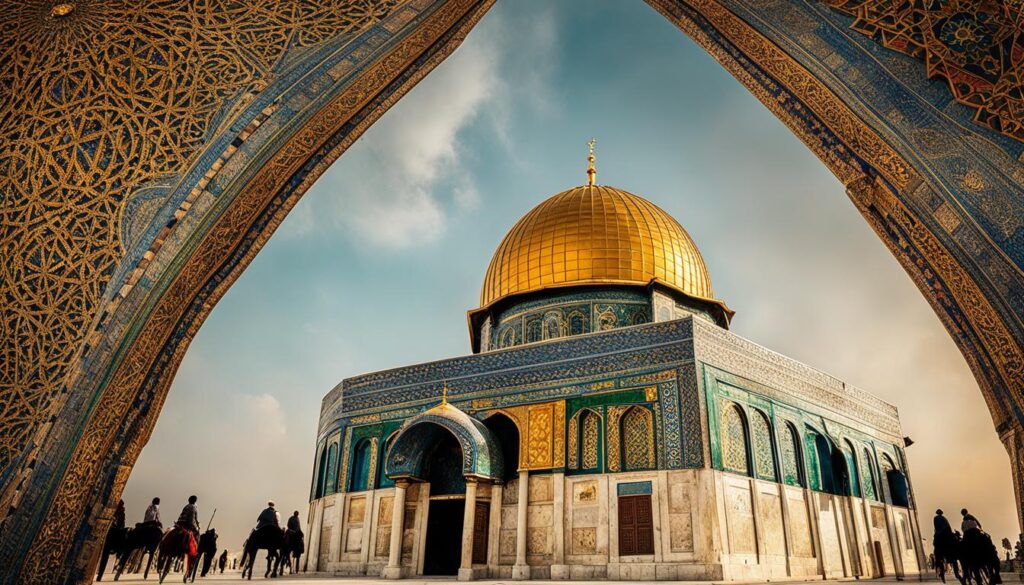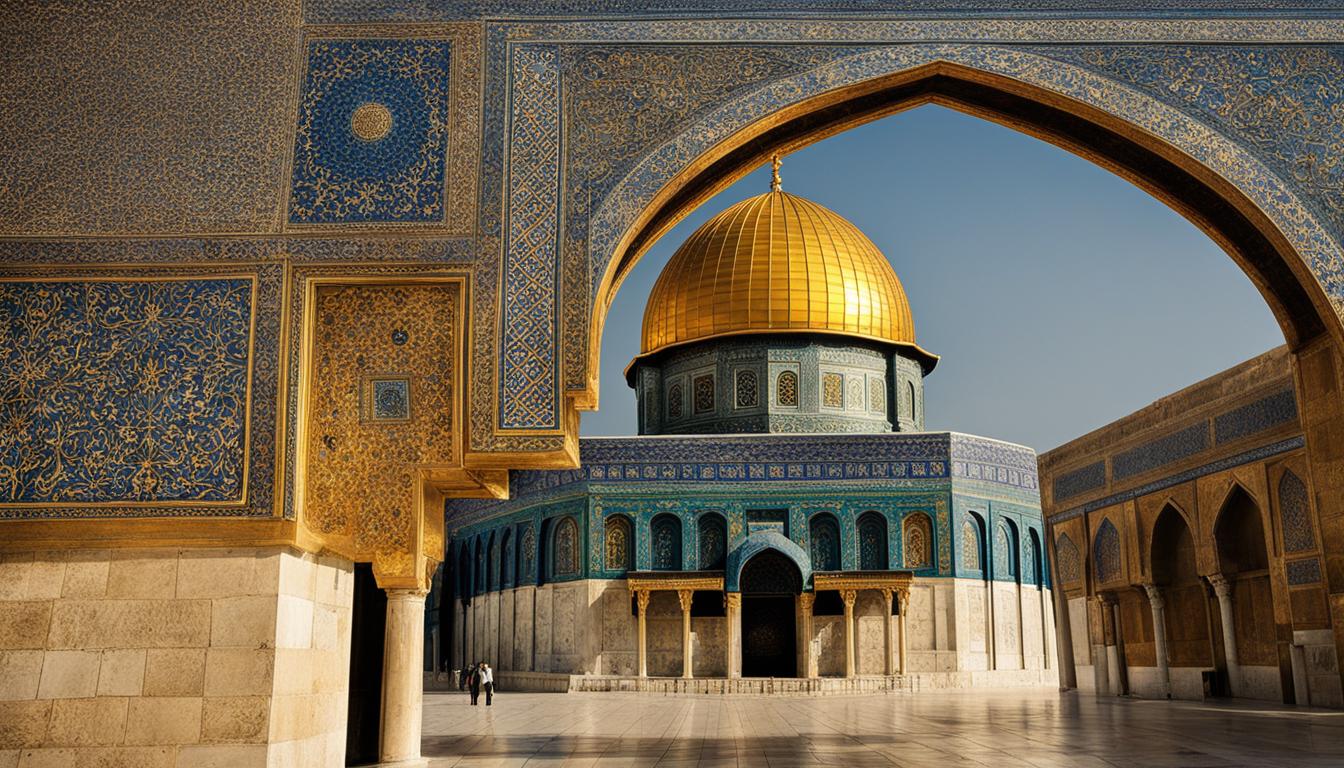The Dome of the Rock, located in Jerusalem’s Temple Mount area, holds immense religious and historical significance to Muslims. It is revered as a sacred site, as Muslims believe it is the spot from which the Prophet Muhammad ascended to Heaven. This iconic octagonal structure serves as a symbol of the triumph of Islam and showcases the early development of the religion.
Additionally, the Dome of the Rock represents the connection between Muslims and their faith. Its architectural features, such as the wooden dome and high drum, contribute to its cultural and religious importance. The Dome of the Rock is also part of the larger al-Aqsa Mosque compound, further enhancing its significance within Islamic tradition.
Over the centuries, the Dome of the Rock has become a place of pilgrimage and worship for Muslims, drawing people from around the world to experience its spiritual atmosphere. However, with its significance comes tensions, as the site has been a source of conflicts between different religious and political groups.
Key Takeaways:
- The Dome of the Rock is of great religious importance to Muslims, symbolizing the ascension of the Prophet Muhammad to Heaven.
- It is the oldest standing monument of Islamic architecture and showcases the early development of the religion.
- The location, architectural features, and connection to the al-Aqsa Mosque compound further enhance its significance in Islam.
- The Dome of the Rock serves as a place of pilgrimage and worship for Muslims.
- Tensions and conflicts surrounding the site highlight its sacred and religious importance.
Historical Significance of the Dome of the Rock in Islam
The Dome of the Rock, with its rich history and architectural grandeur, holds immense historical significance in Islam. This iconic structure stands as the oldest surviving monument of Islamic architecture and is associated with the early development of Islam.
Commissioned by the Umayyad caliph Abd al-Malik and completed between 691 and 692 CE, the Dome of the Rock was built on the site of the Second Jewish Temple. Its construction marked a turning point in Islamic architecture, showcasing the fusion of Byzantine, Persian, and Islamic artistic elements. The octagonal design, the intricate mosaics, and the impressive dome all reflect the mastery of craftsmanship during that era.
Moreover, the Dome of the Rock’s location on the Haram al-Sharif sanctuary further enhances its historical significance. Situated in Jerusalem’s Temple Mount area, this sacred site holds immense importance for Muslims worldwide. The Dome of the Rock, along with the nearby Al-Aqsa Mosque, forms the centerpiece of this revered compound, signifying the religious and cultural connection of Islam to Jerusalem.
The Dome of the Rock: A Historical Timeline
- 691-692 CE: Construction of the Dome of the Rock is completed under the patronage of Umayyad caliph Abd al-Malik.
- 750-940 CE: The interior of the Dome is adorned with intricate mosaics, showcasing floral, geometric, and calligraphic designs.
- Late 12th century: The Crusaders briefly convert the Dome of the Rock into a church, adding Christian elements.
- 16th century: The Ottoman sultan Suleiman the Magnificent undertakes extensive renovations, restoring the Dome to its original splendor.
- 20th century: The Dome of the Rock becomes a potent symbol of Palestinian nationalism and the struggle for self-determination.
The historical significance of the Dome of the Rock in Islam is undeniable. From its architectural marvels to its association with the early development of the Islamic faith, this iconic structure continues to inspire awe and reverence among Muslims around the world.
Religious Symbolisms of the Dome of the Rock
The Dome of the Rock, as a part of the al-Aqsa Mosque compound, carries numerous religious symbolisms that hold deep significance for Muslims.
Firstly, the location of the Dome of the Rock within the larger compound symbolizes the connection between Muslims and their faith. It stands as a prominent architectural landmark, serving as a visual reminder of the strength and endurance of Islam.
Additionally, the Dome of the Rock features inscriptions that hold great religious importance. Arabic calligraphy adorns the walls of the structure, showcasing verses from the Quran and references to Islamic theology. These inscriptions serve as reminders of the religious teachings and beliefs that Muslims hold dear.
The Dome of the Rock is also closely associated with the Night Journey and Ascension of the Prophet Muhammad. It is mentioned in the Quranic verse, adding to its religious significance. This connection to the Prophet’s spiritual journey has made the Dome of the Rock a place of pilgrimage and worship for Muslims around the world.
Architectural Features of the Dome of the Rock
The Dome of the Rock is known for its distinct architectural features that contribute to its cultural and religious importance. This magnificent structure features an octagonal shape, with walls and columns surrounding it. At the top, a wooden dome rests on a high drum, creating a striking silhouette against the sky.
One of the most notable architectural elements of the Dome of the Rock is the Rock itself, which the dome shelters. This Rock is believed to be the spot where the Prophet Muhammad ascended to Heaven during his Night Journey. It holds great reverence for Muslims and adds to the significance of the entire structure.
The interior of the Dome of the Rock is equally impressive. The walls are adorned with intricate mosaics, featuring vibrant colors and intricate patterns. The blind panels and windows allow light to filter through, casting a mesmerizing glow inside the structure. The architectural beauty of the Dome of the Rock is a testament to the skilled craftsmanship of the time and adds to its overall appeal.
Architectural Features of the Dome of the Rock:
- Octagonal structure with a wooden dome on a high drum
- Surrounded by walls and columns
- Intricate mosaics and vibrant colors inside
- Features blind panels and windows for natural light
Al-Aqsa Mosque and the Temple Mount
The Dome of the Rock is part of the larger al-Aqsa Mosque compound, which includes the Al-Aqsa Mosque itself. This compound is located on the Temple Mount, a sacred site for both Muslims and Jews. Muslims consider the entire compound to be the third holiest site in Islam, after Mecca and Medina. The Temple Mount holds significance for Jews as it is believed to be the location of the first and second Jewish temples. The coexistence of the Dome of the Rock and the Temple Mount adds to the religious importance of the site for Muslims.
The al-Aqsa Mosque compound is a place of deep spiritual significance for Muslims. It is a site of pilgrimage and worship, drawing Muslims from all over the world. The compound holds historical and cultural importance as well, serving as a testament to the early development of Islam and the religious symbolisms associated with Jerusalem.
Significance of the Dome of the Rock to Muslims
- The Dome of the Rock represents the spot from which the Prophet Muhammad ascended to Heaven, making it a sacred place for Muslims.
- This iconic structure symbolizes the triumph of Islam and the connection between humanity and God.
- Its architectural features, including the wooden dome and octagonal structure, contribute to its cultural and religious significance.
In conclusion, the Dome of the Rock, as part of the al-Aqsa Mosque compound on the Temple Mount, holds immense religious and historical importance for Muslims. It is a place of worship, pilgrimage, and a symbol of the Muslim faith. With its rich architectural features and association with the early development of Islam, the Dome of the Rock stands as a testament to the significance of Jerusalem in the Islamic tradition.

- Encouraging interfaith dialogue and understanding between different religious groups involved in the conflict can help foster mutual respect and reduce tensions.
- Ensuring equal access and rights for all worshippers, regardless of their religious affiliation, is essential in maintaining the status quo and preventing further conflicts.
- Establishing clear guidelines and protocols for visiting and worshiping at the compound can help prevent misunderstandings and minimize potential sources of tension.
Ultimately, a peaceful and harmonious resolution to the tensions surrounding Al-Aqsa is crucial for the preservation of religious rights, cultural heritage, and the overall stability of the region.
Conclusion
The Dome of the Rock holds immense religious and historical significance for Muslims. It is revered as the spot where the Prophet Muhammad ascended to Heaven, symbolizing the triumph of Islam. The architectural features, such as the octagonal structure and the wooden dome, further contribute to its cultural and religious importance.
Located on the Temple Mount, the Dome of the Rock is part of the larger al-Aqsa Mosque compound, which holds deep religious significance for Muslims. It serves as a symbol of the Muslim faith and a reminder of their connection to God. The historical significance of the Dome of the Rock showcases the early development of Islam and the religious symbolisms associated with Jerusalem.
With its rich history and religious symbolisms, the Dome of the Rock continues to be a place of pilgrimage and worship for Muslims. Despite the tensions and conflicts surrounding the site, it remains a testament to the enduring faith and cultural heritage of Muslims. The Dome of the Rock stands as a testament to the significance of Jerusalem in the Islamic world and its historical role in shaping the Muslim identity.
FAQ
What is the Dome of the Rock?
The Dome of the Rock is an octagonal structure located in Jerusalem’s Temple Mount area.
Why is the Dome of the Rock important to Muslims?
The Dome of the Rock holds significant religious and historical importance to Muslims. They revere it as the spot from which the Prophet Muhammad ascended to Heaven.
When was the Dome of the Rock built?
Construction of the Dome of the Rock was completed between 691 and 692 CE.
What are the religious symbolisms of the Dome of the Rock?
The Dome of the Rock represents the connection between Muslims and their faith. It is mentioned in the Quranic verse recounting the Prophet Muhammad’s Night Journey and Ascension to Heaven.
What are the architectural features of the Dome of the Rock?
The Dome of the Rock features an octagonal structure with a wooden dome set on a high drum. It is surrounded by walls and columns, with windows and blind panels.
What is the connection between the Dome of the Rock and the Temple Mount?
The Dome of the Rock is part of the larger al-Aqsa Mosque compound located on the Temple Mount, a sacred site for both Muslims and Jews.
What tensions surround the Dome of the Rock and the Temple Mount?
The Temple Mount has historically been a source of tension and conflicts between different religious and political groups. The “status quo” arrangement allows non-Muslims to visit the compound, but only Muslims are allowed to worship there.

